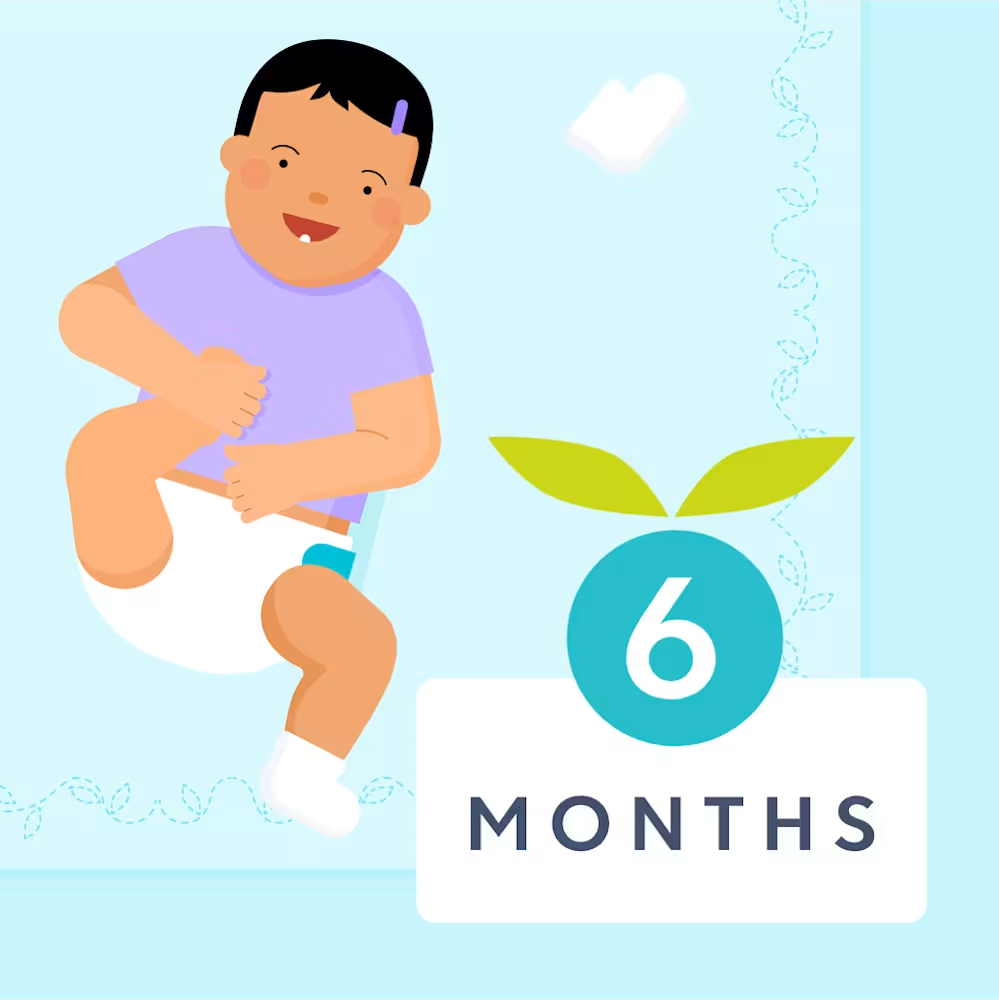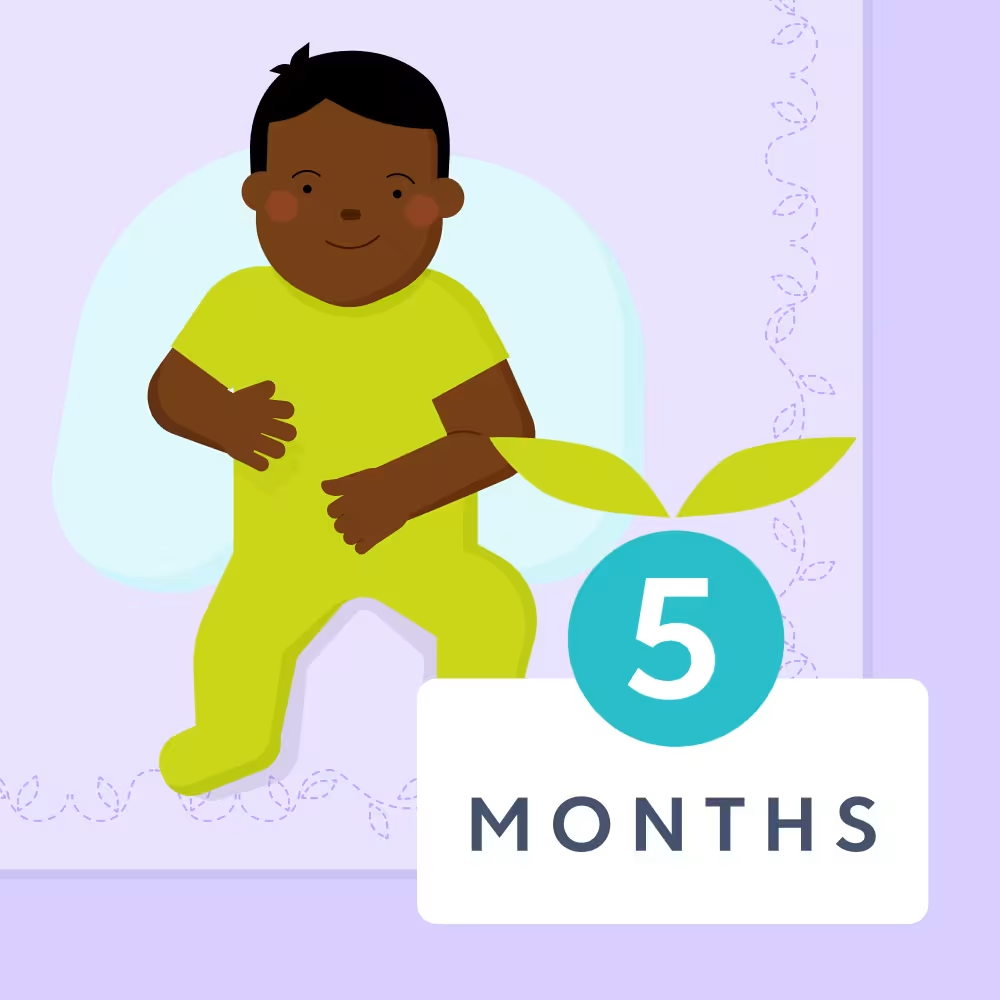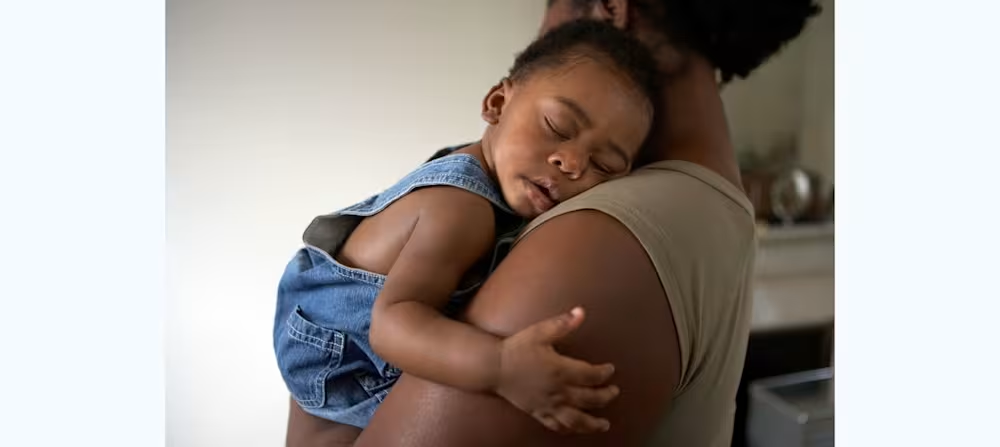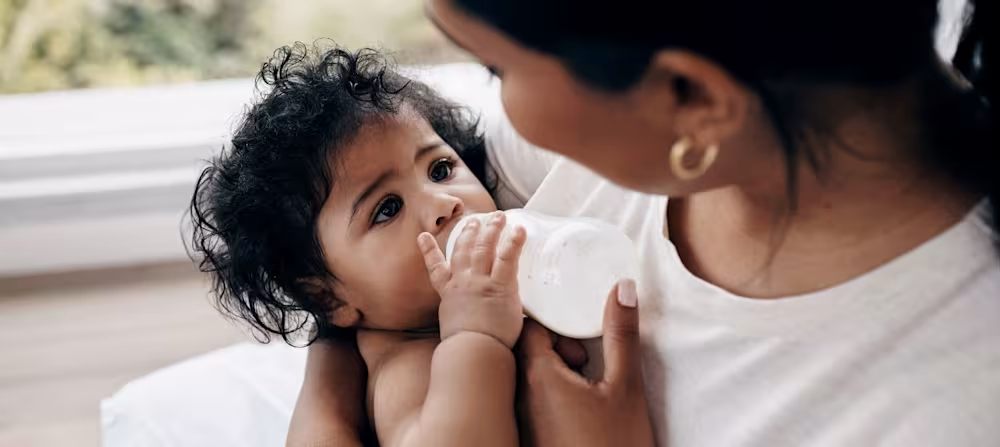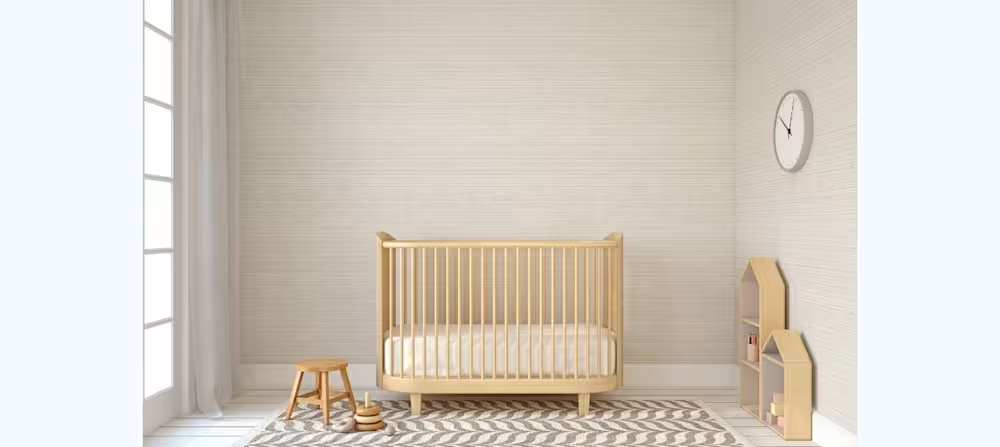6 month old baby milestones: Development, growth, speech, language
Updated Dec 29, 2025

Happy half-birthday to your little one! 6 months is an exciting age where babies seem to learn and grow every day as they work on new milestones like sitting up, rolling over, reaching with their hands, babbling, laughing, and more.
In this article, we’ll take you through the milestones you can expect from 27 - 31 week old babies, give you a handy 6 month old development checklist, and provide useful tips to help ensure your little one is developing and growing as much as possible.
Editor's note
When we discuss babies and development at Huckleberry, we use their adjusted age (vs. actual age). It’s normal for babies to reach 6 month developmental milestones at different times as there’s a wide range of normal when it comes to how fast little ones grow and learn. However, most children will reach these milestones by about 27 - 31 weeks. If you have any concerns or questions about your child’s development, reach out to their pediatrician.
Table of Contents
6 month old baby milestones at a glance
Development:
Your baby at 6 months is probably moving independently! They’re likely rolling from tummy to back as well as back to tummy. At this age, little ones can typically sit up with a little support too. This gives them a whole different point of view when playing and interacting with you.
6 month old language development includes one-syllable babbling sounds like “mamama,” “bababa,” and “dadada.” At this age, babies can also copy gestures like shaking their heads “yes” and “no” and make different sounds to indicate their mood. They are also likely to differentiate familiar faces from strangers at this stage. It’s normal if they express some stranger anxiety too.
Sleep:
At 6 months, we recommend aiming for a over a 24-period, which usually includes about 2.5 - 3.5 hours of daytime sleep spread out over 3 naps. This can vary depending on individual sleep needs, so monitor your baby’s mood and energy levels when evaluating if they’re getting enough sleep.
Wake windows at 6 months are typically around 2 - 3 hours. It’s normal if your baby stays awake for around 2 hours before their morning nap then can comfortably stay awake for closer to 3 hours before bedtime. Wake windows usually extend for babies as the day goes on.
At this age, some babies may be taking 4 naps during the day. If this schedule persists for too long, it can commonly make night sleep too short because a nap late in the day often means a later bedtime. A 4-nap schedule can also perpetuate a cycle of short naps. To solve this, try to increase awake time between daytime sleep and transition to a 3-nap schedule.
For babies already on a 3-nap schedule, it’s also common at this age for little ones to start to resist the third nap of the day. You might think this is a , but resisting naps is a normal (albeit frustrating) phase. Instead of getting rid of the third nap, try to extend wake windows to increase sleep pressure before the last nap of the day. Most babies aren’t quite ready to go to a 2-nap schedule until 7 - 9 months. If your baby drops a nap too early, this can lead to overtiredness that can then lead to issues like increased night waking and fussiness.
Feeding:
Babies will continue to drink breast milk and/or formula for their primary nutritional needs at this age. You may expect your 6 month old to eat up to 8 ounces every 4 - 5 hours []. If your child is growing well and has about 4 - 6 wet diapers per day, these are good indications that your baby is getting enough to eat.
At 6 months babies are usually ready to begin exploring solid foods too if they’re showing important signs of readiness []. These include: holding their head up on their own, sitting up on their own with support, and showing an interest in food by watching food intently and opening their mouth in anticipation of a bite.
When your little one is ready to get started, you can choose to introduce or try (BLW) with table foods or a combination of these two methods. Start by offering solid foods for one meal a day at 6 months old then you’ll gradually work up to adding more meals and snacks as your little one grows and develops. Keep in mind that most babies will only eat small amounts of solid foods at this age. The goal right now is to let your little one explore a variety of foods. Exposure is key, not consumption or calories per day!
Around 6 months is also a good time to offer your , especially during mealtimes. This can help set your baby up for long-term healthy hydration and also allows them to learn new skills like drinking out of a cup and using a straw. Start small by offering an ounce or two of water out of a small cup (think the size of a shot glass) and help your baby take small sips. It’ll likely be a messy endeavor at first, but at this age, it’s more about learning the skill than the amount your baby is drinking.
The American Academy of Pediatrics [] recommends 4 - 8 oz of water per day for babies 6 - 12 months, but most children on the younger end of the range will only drink an ounce or two per day for the first few months of practice.
Growth:
This month [], your little one’s weight gain may be about 1 - 1.25 pounds and they may grow .5 - 75 inches in length. It’s normal if your child grows a little more or less than this between 27 - 31 weeks. Your child’s doctor will chart their height and weight during their 6-month well-baby visit to ensure they’re growing at a regular pace. This will help pinpoint any trends that need attention.
6 month development milestones
Physical development
Gross motor milestones
Rolling both ways: By 6 months, most babies have figured out how to roll over both ways []: from their tummy to back and back to tummy. It’s normal for little ones to master rolling from stomach to back first, so going from back to tummy may be a newer skill for your child.
The American Academy of Pediatrics [] recommends that you stop swaddling your baby as soon as they show signs of being able to roll over. Now that your little one is moving independently, also check to be sure there are no small choking hazards in their play space and consider moving diaper changes to the ground to keep your baby safe.
Sitting with support: Around 6 months most babies are starting to see the world from a whole different point of view thanks to being able to sit up with a little support []! At this age, they’re usually able to sit with their hand(s) in front of them while working on the strength and balance needed to sit independently.
Supporting weight in standing: Another 6 month old gross motor milestone is being able to support their weight on both legs in a standing position when you’re holding them up under their arms. They might bounce while doing this too!
Pre-crawling movements: While crawling isn’t an expected milestone (and some babies may skip crawling!) until closer to 7 - 9 months [], your baby might be working on skills they’ll use for this motor skill. These include [] rocking back and forth on their hands and knees, pivoting in a circle while on their tummy, and reaching for toys while on their stomach.
Fine motor milestones
Exploring with hands: Babies are exploring the world around them at this age and they’re using their fine motor skills and improved hand-eye coordination to do so. 6 month fine motor milestones include working on [] reaching for toys with their right or left hand, shaking objects, and using a raking grasp (grasping with all fingers at the same time).
Transferring objects from hand to hand: Passing an item back and forth [] between their hands may be one of your baby’s favorite activities at 6 months.
Speech development
Babbling: 6 month old speech milestones include making sounds like [] "bababa," "dadada," and "mamama." Although it sounds like they may be saying “mama” and “dada” at this age, babies generally don’t connect meaning [] to words until closer to 8 - 12 months.
Copying gestures: At this age, your baby may be able to copy gestures [] they see you making like nodding their head for “yes” and shaking it for “no.” It’ll make for some adorable videos!
Blow raspberries: Yes, blowing raspberries [] is actually a milestone. Babies typically are able to make these funny, drooly sounds by about 6 months. This skill helps strengthen facial muscles that are important for speech and feeding.
Social development
Emotional development
Knows familiar people: Your baby is starting to figure out who they know and who’s a stranger [] at 6 months. , the precursor to separation anxiety, usually starts around 5 months. This means your baby might be a little unsure of new people and prefer to be around their primary caregivers.
Laughs: Get ready for some adorable baby laughs []! 6 month old emotional development generally includes laughing and, of course, making everyone around them smile in return.
Enjoys interacting with others: Babies are more in tune with the people around them [] at this age. They often enjoy playing social games (like peek-a-boo), responding to other people’s emotions, and making sounds to express their own happiness or displeasure.
27 to 31 week old development milestones checklist
Note that development is on a spectrum and not all children will reach all of these milestones at the same time. Most children will be able to do these things by around 27 - 31 weeks, but this might not always be the case. You know your child best. If you are concerned about potential developmental delays when it comes to 6 month old milestones, reach out to their healthcare provider.
Roll over both ways (back to tummy and tummy to back)
Sit up with little support
Support weight on both legs while being held in a standing position
Explore solid foods
Transfer objects from one hand to the other
Shake, reach, and rake toys with their hands
Babble sounds like "bababa," "dadada," and "mamama”
Copy some gestures
Blow raspberries
Laugh
Enjoy social games and interacting with people
What are 6 month old development red flags?
While every baby grows and develops on their own timeline, there are a few signs around 6 months that may be worth discussing with your baby’s healthcare provider. Consider checking in with your pediatrician if your baby []:
Doesn’t roll over in either direction (tummy to back and back to tummy)
Doesn’t try to grab things that are close by
Doesn't show affection for caregivers
Doesn’t respond to nearby sounds
Has difficulty getting things to mouth
Seems very floppy or stiff
Doesn’t make vowel sounds (like “ah,” “eh,” “oh”)
Isn't laughing or make other squealing sounds
3 development tips for 6 months
Tip | Why it helps | What to try |
|---|---|---|
Point and name | Pointing and naming objects helps babies connect words to the world around them and supports early language development. | Throughout the day, point to items your baby looks at and label them (“That’s your cup!”). Do it during tummy time, diaper changes, walks, or bathtime. |
Encourage rolling | Practicing rolling builds core strength, coordination, and confidence for upcoming milestones like sitting, crawling, and cruising. | Place toys slightly out of reach to spark movement. Give plenty of floor time so your baby can experiment with rolling in both directions. |
Safely introduce allergens | Introducing allergens early and consistently can help lower the risk of developing food allergies (with pediatric guidance). | Once cleared by your child’s doctor, offer small amounts of common allergens, such as peanut, egg, or dairy, regularly as your child starts solids. |
Find more details below:
Tip #1: Here’s the point
When your little one looks at something, point to it, name it, and talk about it. This helps your baby learn words [] and pay attention to the things around them. Do this as much as possible throughout the day during routine activities like tummy time, diaper changes, bathtime, etc.
Tip #2: Roll, roll, roll
Placing toys just out of reach when your baby is playing on the floor is a great way to encourage them to roll over []. Practicing these new motor skills will help your little one gain the strength they need to work on other physical milestones like sitting up and eventually crawling and walking.
Tip #3: All about allergens
When starting solids, introduce such as peanuts, eggs, and dairy unless otherwise instructed by your child’s doctor. Research shows [] that early and frequent exposure to allergens may lower the occurrence of food allergies.
Activities for a 5 month old baby
1. The pick-up game
When your baby drops a toy on the floor, you can help your child learn cause and effect [] by picking it up and giving it back. You may grow weary of this game after a while but chances are your little one will love it.
2. Mirror play
Mirrors are lots of fun for babies at this age. Show your baby their reflection [] and see what kind of reaction you get. Babies at 6 months are too young to recognize themselves [] in the mirror but they’ll likely enjoy seeing themselves anyway.
Caring for a sick child at 6 months
It’s tough when your baby isn’t feeling well — even a mild cold can throw everyone for a loop. The tips below may help while your little one is under the weather. That said, if anything feels off or you notice concerning symptoms, reach out to your baby’s healthcare provider. Trust your instincts — it’s always OK to play it safe.
Hydrate: Keep offering breast milk or formula regularly. If your baby isn’t up for full feeds, try offering smaller amounts more frequently to help them stay hydrated.
Ease congestion: A can make everything harder, especially feeding and sleeping. Try using a cool-mist humidifier, saline drops, and gentle suction to help clear things up, especially before naps and bedtime.
Watch for fever: If your baby has a fever that lasts more than 24 hours or a temperature that repeatedly goes above 104°F (40°C), call their pediatrician right away [].
Be flexible with sleep: Illness can make sleep challenging and unpredictable. Your baby might need more sleep than usual or have trouble falling and staying asleep. Aim to go with the flow while they're feeling yucky then get back to more normal routines once they're better.
Offer extra comfort: Your little one may be harder to settle when they’re not feeling well. They may need more cuddles, rocking, or close contact — or they may want some space and that's normal too. If you’re feeling worn out, try leaning on a partner, friend, or family member for support when you can.
When to seek help
If your child has a fever for more than 24 hours or it reaches above 104°F (40°C), call their doctor right away. These can be signs of a more serious infection or illness and it's best to rule out anything that needs medical attention.
In general, if something feels off or you’re worried about how your child looks or acts, it’s safest to check in with their doctor. And if you already talked to them but symptoms appear worse, that’s a good time to check back in too.
Takeaway: Development milestones for 6 month olds
Babies at 6 months are usually ready to start solid food! This may look like offering purees or trying baby-led weaning. Note at this age eating solids is more about exploration and exposure to a variety of foods than consumption. Offer one solid meal per day at first and build from there in the coming months.
6 month olds are likely rolling both ways and working on sitting up independently. All of that tummy time is helping them master these various motor skills and set the foundation for future milestones like crawling and walking.
You may hear “mamama” and “dadada” from your little one this month. While babies typically don’t connect meaning to their babbles quite yet, these new sounds are adorable and make for great home video moments.
Keep in mind there’s a wide spectrum of normal when it comes to 6 month old baby milestones. It’s OK if your baby isn’t doing all of these things between 27 - 31 weeks. However, consult with your child’s doctor if you have concerns about any 6 month old milestone red flags or delays.
If you're curious about what lies ahead in the coming month, glimpse into the future to see what you might experience once your baby is a . Take a look back at how far your baby has come by revisiting what they may have been like as a .
6 month old development milestones FAQ
Share article:
Note: The content on this site is for informational purposes only and should not replace medical advice from your doctor, pediatrician, or medical professional. If you have questions or concerns, you should contact a medical professional.
17 Sources
Table of Contents
Share article:
